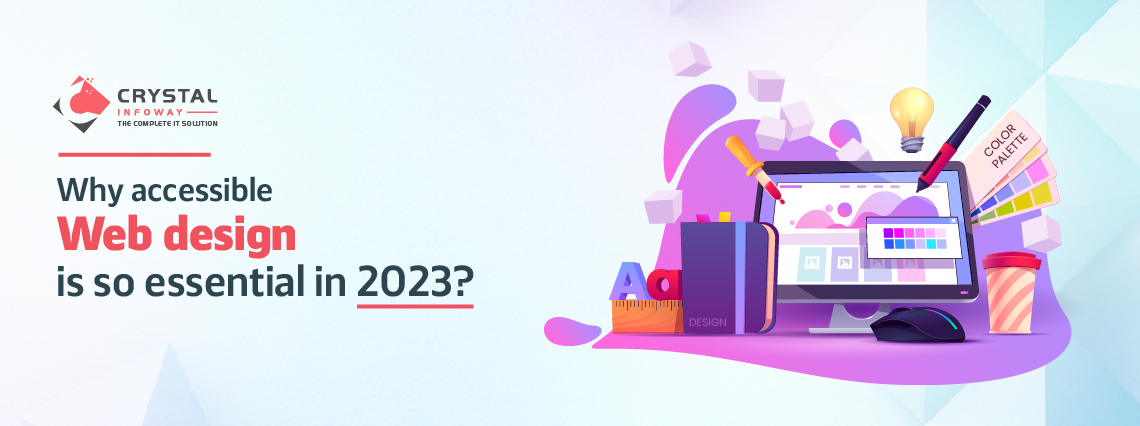
Request a Call Back
Enter your contact details and one of our friendly team member will be in touch soon!.

Enter your contact details and one of our friendly team member will be in touch soon!.

Accessible web design is a set of principles and methods that make websites and applications available to people with disabilities. It involves using the latest technologies, techniques, and standards to ensure that everyone can access digital content without any barriers. In 2023, accessible web design is essential because it allows all users to have an equal opportunity to browse online regardless of their physical or cognitive abilities. Accessible web design ensures that people with different levels of hearing, vision, movement, speech, or cognition can use technology just as well as those without impairments. This not only provides an inclusive user experience but also increases the reach of websites by making them more widely available for people from all walks of life.
Understanding users’ physical and cognitive needs is an important part of developing accessible web design. This means that the website should be designed to meet the requirements of people with different types of disabilities, including those who are deaf or hard-of-hearing, blind or visually impaired, have limited mobility, speech impairments, learning difficulties, and more. It is necessary to ensure that all features can be used in a way that suits each user's individual needs – from changing the text size and color contrast for those with visual impairments to providing audio descriptions for videos for those who are hearing impaired.
Analyzing the benefits of inclusive design is another key factor when it comes to developing accessible websites. By making sure everyone can access content on your site regardless of their abilities, you will not only improve user experience but also increase engagement as well as reach a wider audience due to increased accessibility. Additionally, since many countries now require businesses to comply with laws regarding accessibility compliance (such as the Americans With Disabilities Act) having an accessible website helps organizations remain compliant while avoiding costly fines.
Finally, investing in making websites available ensures digital equality by removing any barriers between users which could limit their ability to access content online. This not only increases usability but also provides greater opportunities for people with disabilities who might otherwise miss out on certain services or experiences due to a lack of accessibility options online.
Ensuring digital content meets accessibility guidelines is essential for providing an inclusive user experience and helping to break down barriers between users. This can be achieved by using the latest technologies and standards such as WCAG (Web Content Accessibility Guidelines) and WAI-ARIA (Web Accessibility Initiative – Accessible Rich Internet Applications).
WCAG is a set of criteria developed by the World Wide Web Consortium that helps ensure digital content is accessible to all users, including those with disabilities. It provides detailed recommendations on how websites should be designed to meet certain accessibility requirements. These include making sure the page structure is logical, text size can be adjusted, color contrast ratios are appropriate, images have alternative descriptions and navigation elements have clear labels. By meeting these guidelines, websites become more usable for everyone involved regardless of their level of ability or impairment.
WAI-ARIA is also an important part of web accessibility as it enables developers to create interactive web applications which are usable by people with disabilities such as blindness or low vision. The WAI-ARIA standard defines ways that software components can communicate with assistive technology like screen readers so they can interpret information correctly when navigating through a website or app interface. Additionally, this standard ensures people who rely on keyboard controls instead of mouse clicks can use a website effectively too.
Overall both WCAG and WAI-ARIA provide useful guidance for developing websites that comply with all necessary accessibility standards while ensuring equal opportunity for users from any background or level of ability to access digital content without any issues or barriers getting in their way.
When it comes to design and development practices for accessible web design, using color guidelines and contrast ratios is essential. This means ensuring that there is a clear distinction between text and background colors as well as making sure the overall visibility of the content on-screen meets certain standards. Additionally, when selecting colors for backgrounds or text, make sure they have sufficient contrast with each other so they can be easily read by people with all types of vision impairments.
Creating user-friendly navigation and forms is also an important part of developing an accessible website. All navigational elements should be clearly labeled to provide context to users with cognitive impairments while form fields should always include helpful instructions alongside them so users know what information needs to be entered in each field correctly.
Including language and reading level settings is another key factor when it comes to accessibility compliance since not everyone speaks or reads English or shares the same literacy level. This can involve providing different versions of content written at different levels depending on their target audience as well as offering translations into multiple languages if necessary too. Additionally, websites can benefit from having tools built-in which allow visitors to adjust font sizes according to their preferences which helps those who are visually impaired more easily read online content without any issues blocking their way either.
Screen readers are an essential tool for ensuring that websites and applications can be used by people who are blind or visually impaired. These programs use a combination of text-to-speech technology and keyboard commands to allow users to navigate through digital content without having to rely on their vision. Screen readers can not only read out page content but also provide helpful feedback such as whether a link has been clicked, what form fields need completing, or which elements have a focus within the page.
Browser extensions are another useful tool when it comes to designing accessible web pages. Extensions like the No Coffee Vision Simulator allow designers to view webpages in various forms of visual impairment to test how user experience is affected when certain features aren’t visible or clear enough for those with vision impairments. Additionally, Colorblind Web Page Filter helps designers make sure there is enough contrast between colors on their website so all users can see them regardless of any color blindness they may have too.
Assistive technologies and tools are also key components of accessible design since they help enhance the usability of digital content specifically tailored toward those with disabilities. Technologies such as switch access devices enable physically disabled users to interact with interfaces using alternative input methods while voice recognition software allows those with hearing impairments to type information into forms by speaking instead of typing it out manually themselves. Additionally, tools like Zoom Text provide magnified views for low-vision users so they can better read small text sizes online without any issues whatsoever getting in their way either
In conclusion, designing accessible websites is increasingly important in 2023 as digital content continues to become more prevalent. Not only does this ensure that everyone can access content on the internet regardless of their abilities but also makes sure digital equality is maintained so all users are provided with equal opportunities when it comes to accessing web resources and services online. Additionally, by making sure websites comply with accessibility regulations, organizations can avoid costly fines while still providing an inclusive user experience for all visitors alike.
Ultimately, investing in accessible web design not only improves usability but also helps break down barriers between users which could otherwise limit their ability to take advantage of specific services or experiences available on the internet today. To make sure websites provide a truly inclusive user experience developers should always use the latest technologies such as WCAG and WAI-ARIA standards while employing color guidelines and contrast ratios appropriately along with creating user-friendly navigation elements and forms too. Assistive technologies like screen readers should also be taken into consideration when building out interfaces to ensure those who are blind or visually impaired can navigate through them without any issues getting in their way either.


Introduction ReactJS and NextJS are two...
Read More
Are you looking for top mobile app develop...
Read More
Introduction React Native and Laravel a...
Read More